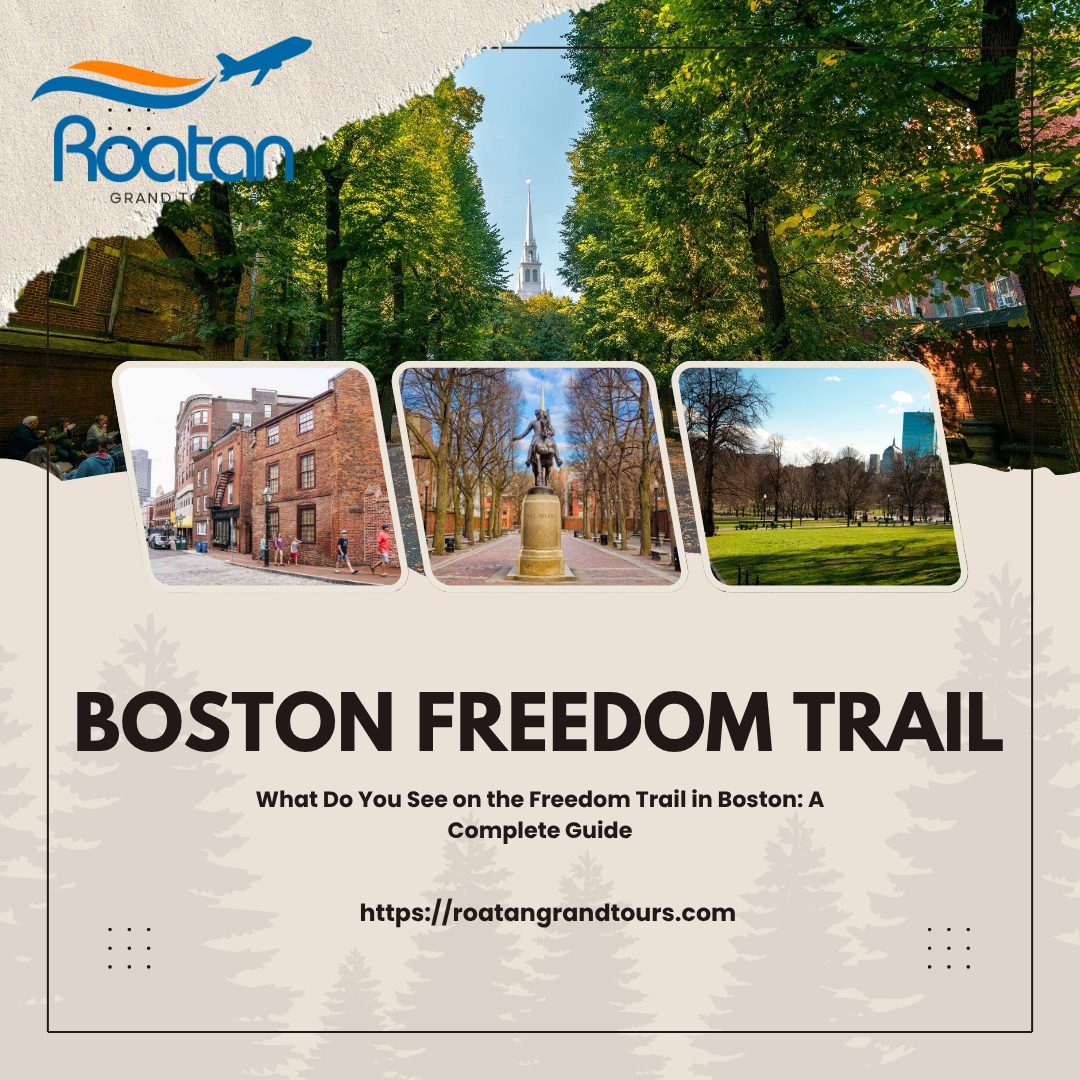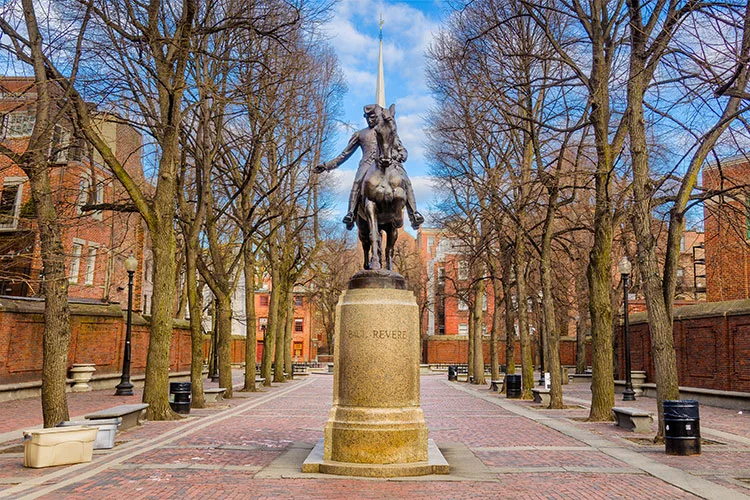What Do You See on the Freedom Trail in Boston: A Complete Guide

What Do You See on the Freedom Trail in Boston: A Complete Guide
Any American city – it’s basically where our entire country got its start. People call it the “Cradle of Liberty,” and honestly? Once you spend some time here, you’ll understand why that nickname stuck.
Think about it: this is where colonists dumped tea into the harbor in protest, where Paul Revere made his famous midnight dash to warn about British troops. These aren’t just stories from a dusty history textbook – they happened right here, on streets you can actually walk on today. It’s pretty incredible when you really think about it.
Now, if you’re planning to visit (and you absolutely should), the Freedom Trail is hands-down the best way to dive into all this history. I’ve walked it myself several times, and it never gets old.
So what exactly is this trail everyone talks about? Picture a 2.5-mile path marked by red bricks that winds through downtown Boston, connecting 16 really important historical spots. A local journalist named William Schofield came up with the idea back in 1958 – pretty brilliant, if you ask me. It’s basically like having a time machine that takes you through 300 years of American history, starting from colonial days right up through the Revolutionary War and beyond.
The numbers are pretty impressive too. More than 4 million people walk this trail every year, which makes it one of New England’s biggest tourist draws. And I can see why – where else can you literally follow in the footsteps of the founding fathers?
Here’s what you need to know before you go: The whole trail covers 2.5 miles and hits 16 official stops. If you’re the type who likes to power through things, you could probably knock it out in 2-3 hours.
But here’s my advice – don’t rush it. Most people (myself included) end up spending closer to 4-6 hours because, well, there’s just so much to see and absorb. You’ll want to read those historical markers, maybe duck into a museum or two, and just soak in the atmosphere. Trust me, it’s worth taking your time with this one.
Here are the essential facts every visitor should know:
| Freedom Trail Quick Facts | Details |
|---|---|
| Total Distance | 2.5 miles (4 km) |
| Number of Official Stops | 16 historical sites |
| Walking Time (Non-stop) | 2-3 hours |
| Recommended Visit Time | 4-6 hours (with site exploration) |
| Annual Visitors | Over 4 million |
| Best Seasons | Spring through Fall (Apr-Oct) |
What Is the Freedom Trail?
Back in the 1950s, Boston had a real problem on its hands. Tourists would arrive eager to soak up all that revolutionary history, only to find themselves completely turned around in the city’s famously confusing tangle of streets. I mean, anyone who’s tried to navigate downtown Boston knows exactly what I’m talking about – those narrow, winding roads seem designed to confuse even locals sometimes!
That’s when local journalist William Schofield had what turned out to be a stroke of genius. Why not create a simple walking route that connects all these historic spots? His idea was beautifully straightforward: link the sites in chronological order so visitors could actually follow the story of America’s birth as they walked.
The solution they came up with is honestly pretty brilliant in its simplicity. They literally painted a red line on the sidewalks – sometimes it’s actual paint, other times it’s red bricks set right into the pavement. You really can’t miss it, even if you’re the type who usually gets lost in a paper bag. Along the way, bronze markers and plaques pop up to give you the backstory and point you toward your next destination.
These days, you’ve got plenty of options for tackling the Freedom Trail. The classic approach? Just follow that red line wherever it takes you. Go at your own speed, linger at the spots that grab your attention, skip past others if they don’t. Lots of people swear by the official Boston National Historical Park app – it’s got audio commentary that makes you feel like you’ve got a personal tour guide in your pocket, plus maps and extra tidbits you won’t find on the plaques.
If you prefer having an actual human guide, there are tons of tour companies that’ll walk you through it. These usually run about 90 minutes to two hours, and many feature guides in period costumes who really know how to spin a tale. They’ll act out scenes and share stories that bring those cobblestones to life. The National Park Service runs free tours too, though they typically focus on just part of the trail rather than the whole shebang.
Here’s a tip from someone who’s seen plenty of visitors wander around looking confused: grab a free map from the visitor center at Faneuil Hall before you start, or at least download that app I mentioned. Sure, the trail is marked well enough, but having a map lets you figure out where you want to spend your time. Trust me, some stops are worth an hour of your day, while others might only need a quick photo and you’re ready to move on.
Top Highlights on the Freedom Trail
📍 Freedom Trail Sites Timeline
King’s Chapel
Faneuil Hall
Tea Party
Bunker Hill
| Site | Year Est. | Key Historical Event | Admission | Time Needed |
|---|---|---|---|---|
| Boston Common | 1634 | America’s oldest public park | FREE | 30 mins |
| Massachusetts State House | 1798 | Government seat, golden dome | FREE | 45 mins |
| Granary Burying Ground | 1660 | Graves of Adams, Hancock, Revere | FREE | 20 mins |
| Old South Meeting House | 1729 | Boston Tea Party planning | $12 | 45 mins |
| Old State House | 1713 | Declaration of Independence read | $15 | 60 mins |
| Faneuil Hall | 1743 | “Cradle of Liberty” meetings | FREE | 30 mins |
| Paul Revere House | 1680 | Home during midnight ride | $6 | 30 mins |
| Old North Church | 1723 | “One if by land, two if by sea” | $8 | 30 mins |
| USS Constitution | 1797 | “Old Ironsides” naval victories | FREE | 60 mins |
| Bunker Hill Monument | 1843 | First major Revolutionary battle | FREE | 45 mins |
Boston Common

Your Freedom Trail journey begins at Boston Common, America’s oldest public park, established in 1634. Originally used as a communal grazing ground for cattle and as a military training field, the Common spans 50 acres in the heart of downtown Boston. This green oasis has witnessed everything from public hangings in colonial times to Vietnam War protests in the 1960s.
The Common serves as the official starting point of the Freedom Trail, marked by a visitor information center where you can orient yourself and gather materials for your walk. The park itself offers beautiful tree-lined paths, a central pond where swan boats operate in warmer months, and the iconic Make Way for Ducklings bronze sculptures that delight children and adults alike.
During winter months, the Common transforms into a winter wonderland with the Frog Pond serving as a public ice skating rink. The park provides a peaceful contrast to the urban energy surrounding it and offers your first glimpse into how Boston balances its historical significance with modern urban life.
Massachusetts State House
Just across Beacon Street from the Common stands the magnificent Massachusetts State House, crowned by its gleaming golden dome that has become one of Boston’s most recognizable landmarks. Completed in 1798, the building was designed by renowned architect Charles Bulfinch and represents one of the finest examples of Federal architecture in America.
The dome, originally made of wood and covered with copper by Paul Revere’s company, was later gilded with gold leaf in 1874. During World War II, the dome was painted gray to prevent it from serving as a landmark for enemy aircraft, but it was restored to its golden glory after the war.
The State House offers free guided tours that take visitors through the historic halls where Massachusetts government has operated for over two centuries. You’ll see the Hall of Flags, displaying battle flags from Massachusetts regiments dating back to the Civil War, and the Great Hall with its stunning stained glass windows depicting scenes from Massachusetts history.
Park Street Church
Standing at the corner of Park and Tremont Streets, Park Street Church earned the nickname “Brimstone Corner,” partly due to the fiery sermons delivered from its pulpit and partly because gunpowder was stored in its basement during the War of 1812. Built in 1809, this Congregational church played a crucial role in the abolitionist movement that would eventually help end slavery in America.
The church’s 217-foot steeple has been a Boston landmark for over two centuries, and its architectural beauty exemplifies the Federal style popular in early 19th-century New England. More importantly, this is where William Lloyd Garrison delivered his first major anti-slavery speech in 1829, launching a movement that would help shape American history.
The church also holds the distinction of hosting the first public performance of “America (My Country ‘Tis of Thee)” in 1831, adding a musical milestone to its historical significance. Today, the church continues to operate as an active congregation while welcoming visitors interested in its rich history.
Granary Burying Ground
Perhaps no stop on the Freedom Trail offers a more direct connection to the personalities who shaped the American Revolution than the Granary Burying Ground. Established in 1660, this cemetery serves as the final resting place for some of the most famous names in American history.
Here lie the remains of three signers of the Declaration of Independence: Samuel Adams, the firebrand organizer of the Boston Tea Party; John Hancock, whose large signature on the Declaration became legendary; and Robert Treat Paine, a lawyer and judge who helped prosecute the British soldiers involved in the Boston Massacre. The cemetery also contains the grave of Paul Revere, whose midnight ride warned of the approaching British troops.
Other notable burials include Crispus Attucks, widely considered the first casualty of the American Revolution when he was killed in the Boston Massacre, and the victims of the Boston Massacre, who are buried in a shared grave marked by a simple but moving memorial.
The cemetery’s weathered headstones, with their distinctive carved skulls and willow trees, provide a tangible connection to colonial-era Boston. Walking among these graves offers a moment of reflection on the sacrifices made by ordinary people who became extraordinary historical figures.
King’s Chapel and Burying Ground
King’s Chapel represents a unique chapter in Boston’s religious history as the first Anglican church established in Puritan New England. Built in 1754, the stone church replaced an earlier wooden structure and served the British colonial government and loyalist population of Boston.
The church’s history took a dramatic turn during the American Revolution. When the British evacuated Boston in 1776, most of the Anglican congregation fled with them, leaving the church nearly empty. In a remarkable transformation, the remaining congregation evolved into the first Unitarian church in America, representing a significant shift in American religious thought.
The adjacent burying ground, established in 1630, is actually older than the church and contains Boston’s oldest grave marker. Notable burials include John Winthrop, the first governor of the Massachusetts Bay Colony, and Mary Chilton, traditionally recognized as the first woman to step off the Mayflower at Plymouth Rock.
The chapel’s interior features an impressive pulpit and beautiful architecture that reflects both its Anglican origins and Unitarian evolution. The contrast between the ornate church and the simple Puritan graves in the adjacent cemetery illustrates the religious tensions that characterized colonial Boston.
Boston Latin School Site and Benjamin Franklin Statue
At the corner of School Street stands a bronze statue of Benjamin Franklin, marking the approximate site of Boston Latin School, America’s first public school, founded in 1635. This location represents the beginning of public education in America and honors one of Boston’s most famous native sons.
Franklin attended Boston Latin School as a young boy, though he left at age 10 to work in his father’s candle-making business. Despite his abbreviated formal education, Franklin went on to become one of America’s most accomplished founding fathers, excelling as a scientist, inventor, diplomat, and philosopher.
The statue, created by sculptor Richard Saltonstall Greenough in 1856, depicts Franklin as a young man and serves as a reminder that even the most extraordinary individuals often have humble beginnings. The inscription on the statue’s base includes Franklin’s famous words about the value of education and self-improvement.
The original Boston Latin School building no longer stands here, but the school continues to operate in the Fenway area of Boston, maintaining its status as the oldest continuously operating public school in America. Notable alumni include four Harvard presidents, four Massachusetts governors, and five signers of the Declaration of Independence.
Old South Meeting House
The Old South Meeting House stands as one of the most important sites in the lead-up to the American Revolution. Built in 1729 as a Puritan meeting house, this building hosted some of the most significant political gatherings in colonial American history, earning it recognition as the birthplace of the American Revolution.
The most famous event held here was the meeting on December 16, 1773, when over 5,000 colonists gathered to protest the Tea Act. When negotiations with British authorities failed, Samuel Adams allegedly gave the signal that sent the Sons of Liberty to Boston Harbor to dump 342 chests of tea into the water, an act of defiance known to history as the Boston Tea Party.
The meeting house also served as the gathering place for protests against the Stamp Act and other British colonial policies. The building’s large capacity made it the de facto town hall for political meetings too large for Faneuil Hall. The phrase “Boston Tea Party” was actually coined at a later meeting held in this building.
Today, the Old South Meeting House operates as a museum with multimedia presentations that bring the events of 1773 to life. Visitors can stand in the same room where American patriots made the fateful decision to defy British authority, setting in motion the chain of events that would lead to the American Revolution.
Old State House
The Old State House, built in 1713, served as the seat of the Massachusetts colonial government and later the state government until 1798. This brick building with its distinctive white clock tower and colorful facade represents the center of political power in colonial Boston and witnessed some of the most dramatic events leading to the American Revolution.
From the building’s east balcony, the Declaration of Independence was first read to Bostonians on July 18, 1776, just four days after its adoption in Philadelphia. The reading drew massive crowds who celebrated in the streets, and the royal symbols on the building were torn down and burned in a bonfire that symbolized the end of British rule.
The building is perhaps most famous for what happened just outside its doors on March 5, 1770. British soldiers fired into a crowd of protesters, killing five colonists in what became known as the Boston Massacre. This event, immortalized in Paul Revere’s famous engraving, galvanized colonial opposition to British rule and became a powerful propaganda tool for the independence movement.
Today, the Old State House operates as a museum managed by the Bostonian Society. The exhibits inside detail the building’s role in colonial government and the events leading to the Revolution. Visitors can see the chamber where the colonial legislature met and learn about the complex relationship between the colonists and British authorities.
Boston Massacre Site
Directly in front of the Old State House, a circle of cobblestones embedded in the modern street marks the site of the Boston Massacre. On the evening of March 5, 1770, tensions between British soldiers and Boston civilians reached a breaking point when soldiers fired into a crowd of protesters, killing five men and wounding six others.
The victims included Crispus Attucks, a man of African and Native American descent who is often considered the first casualty of the American Revolution. Also killed were Samuel Gray, James Caldwell, Samuel Maverick, and Patrick Carr. These men became martyrs for the cause of American independence, and their deaths were used by colonial leaders to rally opposition to British rule.
The event was masterfully publicized by Paul Revere, whose engraving of the massacre depicted it as an unprovoked attack on innocent civilians. While historians debate the exact circumstances of the confrontation, there’s no question that the Boston Massacre became a turning point in the relationship between Britain and its American colonies.
John Adams, despite his opposition to British policies, courageously agreed to defend the British soldiers in court, believing that everyone deserved a fair trial. His successful defense of most of the soldiers demonstrated the colonists’ commitment to the rule of law, even in the face of tragedy and anger.
Faneuil Hall
Known as the “Cradle of Liberty,” Faneuil Hall has served as a marketplace and meeting hall since 1743. Built by wealthy merchant Peter Faneuil as a gift to the city, the building quickly became the center of political activity in colonial Boston and the site of numerous meetings that helped foment the American Revolution.
The hall’s great room on the second floor hosted countless meetings where colonial leaders like Samuel Adams and James Otis delivered fiery speeches against British policies. These gatherings helped organize resistance movements, including the protests against the Stamp Act and the organization of the Boston Tea Party. The phrase “taxation without representation” was popularized at meetings held in this very room.
The building’s first floor originally served as a marketplace, a function it continues to serve today as part of the larger Quincy Market complex. This combination of commerce and politics reflected the practical concerns of Boston’s merchants and artisans, who understood that British economic policies threatened their livelihoods.
Today, Faneuil Hall continues to host political meetings and civic events, maintaining its role as a center of democratic discourse. The hall houses a museum operated by the National Park Service, and visitors can see the great room where American independence was debated and planned. The building also contains a military museum on the fourth floor, showcasing artifacts from Boston’s military history.
Paul Revere House
The Paul Revere House, built around 1680, is the oldest building in downtown Boston and offers visitors a rare glimpse into colonial domestic life. This modest wooden house was home to Paul Revere, his wife, and their 16 children during the most famous period of his life, including the night of his legendary midnight ride on April 18, 1775.
Revere was much more than just a midnight messenger; he was a skilled silversmith, engraver, and businessman who played crucial roles in the Sons of Liberty and other revolutionary organizations. His house reflects the life of a successful middle-class artisan in colonial Boston. The restored interior features period furniture and household items that show how families lived in the 18th century.
The house museum tells the complete story of Revere’s life, from his work as a craftsman to his role in revolutionary politics. Visitors can see examples of his silverwork, including the famous Boston Massacre engraving that helped rally colonial opposition to British rule. The museum also explains the events leading up to his famous ride and what happened that night when he warned Samuel Adams and John Hancock that British troops were marching toward Lexington and Concord.
Perhaps most importantly, the house helps visitors understand that the heroes of the American Revolution were ordinary people who made extraordinary choices. Revere’s modest home reminds us that the fight for independence was carried out by working people who risked everything for the cause of freedom.
Old North Church
Officially known as Christ Church, the Old North Church is forever linked to Paul Revere’s midnight ride through Henry Wadsworth Longfellow’s famous poem. Built in 1723, this Anglican church played a crucial role in the events of April 18, 1775, when church sexton Robert Newman climbed the steeple to hang two lanterns, signaling that British troops were crossing the Charles River by boat rather than marching overland.
The signal “one if by land, two if by sea” was actually part of a backup communication system. Revere had already been informed of the British route and was beginning his ride when the lanterns were lit. The signal was meant to alert other patriots in Charlestown in case Revere was captured before he could cross the river.
The church’s interior remains largely unchanged since colonial times, with its high-backed box pews and soaring windows creating an atmosphere that transports visitors back to the 18th century. The church still holds regular worship services, maintaining its role as an active Episcopal congregation while serving as one of Boston’s most important historical sites.
Behind the church lies a small garden where visitors can reflect on the events that unfolded here. The church also operates a museum in its undercroft, where exhibits detail the church’s history and its role in the American Revolution. The famous steeple, rebuilt after hurricane damage in 1954, continues to serve as a symbol of American freedom and the power of ordinary people to change history.
Copp’s Hill Burying Ground
Copp’s Hill Burying Ground, established in 1659, serves as the final resting place for many of Boston’s colonial-era residents, including free blacks, artisans, and merchants who lived in the North End. The cemetery’s elevated location provided strategic value during the Revolutionary War, when British forces used it as a battery position to bombard Charlestown during the Battle of Bunker Hill.
The cemetery contains the graves of several notable figures, including the Mather family, prominent Puritan ministers who influenced New England religious and intellectual life for generations. Cotton Mather, famous for his role in the Salem witch trials and his promotion of smallpox inoculation, is buried here alongside his father, Increase Mather, and grandfather, Richard Mather.
The cemetery also holds significance for African American history, as it contains the graves of hundreds of free blacks who lived in colonial Boston. Prince Hall, founder of the first lodge of Black Freemasons in America, is buried here, along with many other members of Boston’s early African American community.
Walking through Copp’s Hill offers spectacular views of Boston Harbor and Charlestown, including the Bunker Hill Monument and the USS Constitution. The weathered headstones, many bearing distinctive Puritan symbols like skulls with wings and willow trees, provide a tangible connection to Boston’s colonial past and remind visitors of the diverse community that existed in early America.
USS Constitution and Museum
At the Charlestown Navy Yard, the Freedom Trail concludes with “Old Ironsides,” the USS Constitution, the world’s oldest commissioned naval vessel still afloat. Launched in 1797, the Constitution earned its nickname during the War of 1812 when British cannonballs seemed to bounce off its thick oak hull, leading sailors to exclaim that the ship had sides of iron.
The Constitution’s most famous victory came against HMS Guerriere in August 1812, a triumph that boosted American morale during a difficult war and established the young United States Navy as a force to be respected. The ship went on to defeat four more British vessels during the war, earning a place in American naval legend.
Today, the Constitution remains an active U.S. Navy ship with a crew of active-duty sailors who serve as both historians and guardians of this national treasure. Visitors can tour the ship’s gun decks, crew quarters, and captain’s cabin while learning about life aboard a 19th-century warship. The experience includes demonstrations of naval traditions and explanations of the ship’s construction and armament.
The adjacent USS Constitution Museum provides deeper context about the ship’s history and the broader story of the early American Navy. Interactive exhibits allow visitors to experience what it was like to serve aboard the Constitution, from hauling cannons to navigating by the stars. The museum also explores the ship’s role in American culture and its symbolism as a representation of American resilience and determination.
Bunker Hill Monument
The Freedom Trail’s final stop is the Bunker Hill Monument, a 221-foot granite obelisk that commemorates the first major battle of the American Revolution. The Battle of Bunker Hill, fought on June 17, 1775, actually took place on nearby Breed’s Hill, but the misnomer has persisted throughout history.
Although technically a British victory, the battle proved that colonial forces could stand against professional European troops. The Americans inflicted heavy casualties on the British forces, including many officers, leading British General Henry Clinton to observe that “a few more such victories would have shortly put an end to British dominion in America.”
The monument, completed in 1843, stands 221 feet tall and contains 294 steps leading to an observation deck that offers spectacular views of Boston and its harbor. The climb is challenging but rewarding, providing a physical reminder of the effort required to achieve the freedoms we enjoy today.
The Bunker Hill Museum, located in the adjacent lodge, tells the story of the battle through exhibits and multimedia presentations. Visitors can learn about the key figures involved, including Colonel William Prescott, who allegedly gave the famous order “Don’t fire until you see the whites of their eyes,” and Dr. Joseph Warren, a prominent Boston physician and political leader who was killed in the battle.
How to Explore the Freedom Trail
🚶♂️ Trail Exploration Options Comparison
| Option | Duration | Cost | Pros | Best For |
|---|---|---|---|---|
| Self-Guided | 2-6 hours | Free + site admissions | Flexible pace, detailed exploration | Independent travelers |
| Guided Tour | 90-120 min | $25-45 | Expert commentary, entertainment | First-time visitors |
| Audio Guide | 3-4 hours | Free app | Professional narration, flexible | Tech-savvy visitors |
| Trolley Tour | Full day | $45-65 | No walking, hop-on/hop-off | Limited mobility |
🌞 Best Visiting Seasons
Mild weather, fewer crowds, blooming flowers
Warmest weather, all sites open, busy crowds
Beautiful foliage, comfortable temps, ideal conditions
⏰ Time Budget Planning
Deciding how to experience the Freedom Trail depends on your interests, time constraints, and personal preferences. The self-guided approach offers maximum flexibility, allowing you to spend as much time as you want at each site and skip locations that don’t interest you. This method works particularly well for visitors who enjoy reading historical markers and exploring at their own pace.
Guided tours provide the advantage of expert commentary and storytelling that brings history to life in ways that plaques and signs cannot. Professional guides often share anecdotes and lesser-known details that enhance the experience significantly. Many tours are led by costumed interpreters who add theatrical elements to the historical narrative, making the experience especially engaging for families with children.
The best time to visit the Freedom Trail is generally late spring through early fall, when weather conditions are most favorable for walking and most historic sites maintain extended hours. Summer months offer the longest days and warmest weather, but also bring the largest crowds and highest temperatures. Fall provides beautiful foliage and comfortable temperatures, while spring offers mild weather and fewer tourists.
Winter visitors should be prepared for cold temperatures, snow, and ice, but they’ll also encounter smaller crowds and a unique perspective on how Bostonians lived through harsh New England winters. Many indoor sites remain open year-round, making winter visits entirely feasible for those properly dressed for the weather.
The Freedom Trail is generally accessible to visitors with mobility challenges, though some limitations exist. Most sites are at ground level or have ramp access, and many historic buildings have been retrofitted with elevators. However, some locations like the Bunker Hill Monument and Old North Church steeple require climbing stairs and may not be suitable for all visitors. The National Park Service provides detailed accessibility information for each site on their website.
Local Tips for a Great Experience
🍽️ Freedom Trail Dining & Refreshment Guide
| Location on Trail | Recommended Spots | Specialty | Price Range |
|---|---|---|---|
| Boston Common Area | Tatte Bakery & Café | European pastries, coffee | $5-15 |
| Downtown Crossing | Boston Common Coffee | Local coffee, light bites | $3-12 |
| Faneuil Hall | Quincy Market Food Hall | Diverse food court options | $8-20 |
| North End | Mike’s Pastry | Famous cannoli | $3-8 |
| North End | Modern Pastry | Italian pastries, sfogliatelle | $2-6 |
| Charlestown | Monument Restaurant | Historic tavern fare | $12-25 |
Essential Gear
- ✓ Comfortable walking shoes
- ✓ Weather-appropriate layers
- ✓ Water bottle
- ✓ Phone/camera
Budget Breakdown
Nearby Attractions
- • Boston Tea Party Ships
- • New England Aquarium
- • Boston Harbor Islands
- • Museum of Science
Comfortable walking shoes are absolutely essential for enjoying the Freedom Trail. The 2.5-mile route includes various surfaces, from modern sidewalks to historic cobblestones, and many visitors underestimate the amount of walking involved when they factor in exploring the sites themselves. Weather-appropriate clothing is equally important, as much of the trail is outdoors and Boston weather can change quickly.
The Freedom Trail passes through some of Boston’s best neighborhoods for dining and refreshments. In the North End, you’ll find excellent Italian restaurants and cafes, including the famous Mike’s Pastry for cannoli and Modern Pastry for sfogliatelle. Near Faneuil Hall, Quincy Market offers numerous food stalls and restaurants in a historic setting.
For coffee breaks along the route, Boston Common Coffee Company near the State House provides excellent coffee and light snacks, while Tatte Bakery & Cafe locations throughout downtown offer European-style pastries and artisanal coffee. The North End features several excellent espresso bars that reflect the neighborhood’s Italian heritage.
Several attractions near the Freedom Trail deserve consideration for visitors with extra time. The Boston Tea Party Ships & Museum offers an interactive experience that complements the trail’s focus on the events leading to the Revolution. The New England Aquarium, located near the harbor, provides a completely different but equally engaging Boston experience.
Shopping enthusiasts will enjoy exploring the boutiques and specialty stores in the North End and around Faneuil Hall. The area offers everything from Italian specialty foods to Revolutionary War memorabilia, providing opportunities to take home unique souvenirs that connect to Boston’s history.
Frequently Asked Questions
How long does it take to walk the Freedom Trail? The complete trail takes 2-3 hours if you’re simply walking from site to site without stopping. However, most visitors spend 4-6 hours when they take time to read historical markers, visit museums, and explore the sites thoroughly. Some visitors prefer to spread the experience over two days, allowing more time for in-depth exploration.
Is the Freedom Trail free? Following the red-brick path and reading the outdoor historical markers is completely free. However, several sites along the trail charge admission fees for interior tours and museums. These include the Old South Meeting House, Old State House, Paul Revere House, and USS Constitution Museum. Fees typically range from $3 to $15 per site, with discounts available for students, seniors, and families.
Are pets allowed on the Freedom Trail? Pets are welcome on the outdoor portions of the Freedom Trail, as most of the route follows public sidewalks and parks. However, pets are generally not allowed inside historic buildings and museums, with the exception of service animals. Pet owners should plan accordingly and consider the needs of their animals during what can be a lengthy walking tour.
Do I need to book anything in advance? For self-guided tours, no advance booking is necessary. However, if you’re interested in guided tours, especially during peak tourist season, advance reservations are recommended. Some popular guided tours sell out quickly, particularly those offered on weekends and holidays.
What’s the best starting point? While Boston Common is the official starting point, you can begin the trail at any location. Some visitors prefer starting at the USS Constitution and working backward, especially if they’re staying in hotels near the harbor. Others choose to start at sites that open earliest in the day to maximize their time at indoor attractions.
Conclusion
Walk Through American History
Historical Richness
Experience 300+ years of American history in one walkable trail
Personal Connection
Walk where the founders walked, stand where they stood
Living Democracy
See where American democratic ideals were born and fought for
Your Journey Awaits
The Freedom Trail offers an unparalleled opportunity to walk through the birthplace of American independence and experience the sites where ordinary colonists made extraordinary decisions that changed the course of world history. From the Boston Common, where British troops once camped, to Bunker Hill, where Americans proved they could stand against professional soldiers, every stop along the trail tells part of the larger story of how thirteen colonies became the United States of America.
🎯 Ready to Start Your Freedom Trail Adventure?
Choose self-guided or join a tour
Comfortable shoes & weather gear
4-6 hours for full experience
The Freedom Trail offers an unparalleled opportunity to walk through the birthplace of American independence and experience the sites where ordinary colonists made extraordinary decisions that changed the course of world history. From the Boston Common, where British troops once camped, to Bunker Hill, where Americans proved they could stand against professional soldiers, every stop along the trail tells part of the larger story of how thirteen colonies became the United States of America.
The trail’s genius lies not just in its historical significance, but in its accessibility. Unlike many historical experiences that require extensive travel or expensive admission fees, the Freedom Trail brings American history directly to visitors’ feet. The red-brick path connects not just physical locations, but the ideas, events, and personalities that shaped our nation’s founding.
Whether you’re a history enthusiast seeking to deepen your understanding of the American Revolution, a family looking to make learning fun and engaging, or a visitor wanting to understand what makes Boston special, the Freedom Trail offers something meaningful for everyone. The stories you’ll encounter along the way—of courage and compromise, of ordinary people rising to meet extraordinary challenges—remain as relevant today as they were 250 years ago.
Plan your visit to Boston and make time to follow the red-brick path through American history. Walk where the founders walked, stand where they stood, and gain a deeper appreciation for the freedoms we often take for granted. The Freedom Trail isn’t just a tourist attraction; it’s a pilgrimage through the places where American democracy was born, and every American should experience it at least once in their lifetime.
| ❓ Freedom Trail FAQ Quick Reference | |
|---|---|
| How long does it take? | 2-3 hours walking only, 4-6 hours with site visits |
| Is it free? | Outdoor trail is free, some indoor attractions charge $3-15 |
| Are pets allowed? | Yes on outdoor portions, service animals only indoors |
| Best starting point? | Boston Common (official start) or any site that interests you |
| Advance booking needed? | Only for guided tours, especially during peak season |
| Accessibility options? | Most sites accessible, some stairs (Bunker Hill, church steeples) |
| Best time to visit? | April-October for weather, early morning or late afternoon for crowds |
| Parking available? | Limited street parking, use public transit (T) recommended |
🚇 Getting There
Park Street, Downtown Crossing, State, Government Center stations
Boston Common Garage, Government Center Garage
Most downtown hotels within 10-15 minutes
📱 Digital Resources
Boston National Historical Park app (free)
nps.gov/bost for current hours & info
Free printed maps at visitor centers
📊 Freedom Trail by the Numbers
All Categories
Recent Posts
How to Travel to Roatan Honduras
What’s the Best Month to Visit Roatan? Complete Planning Guide





